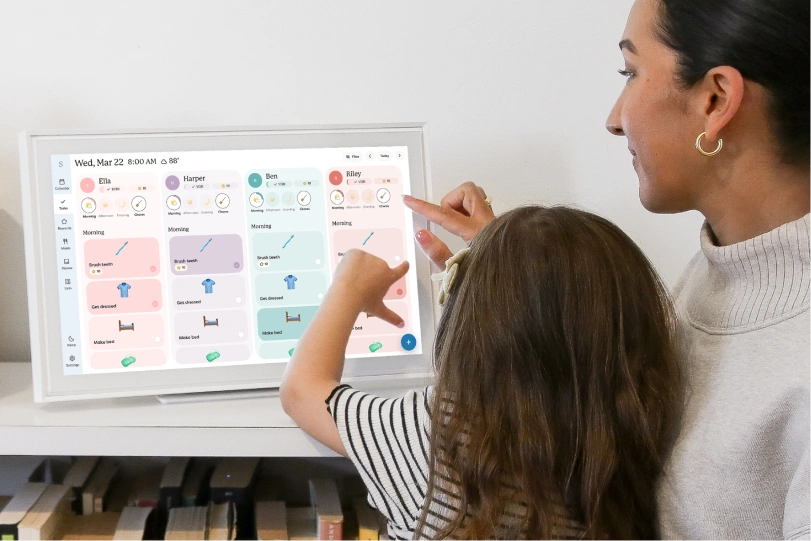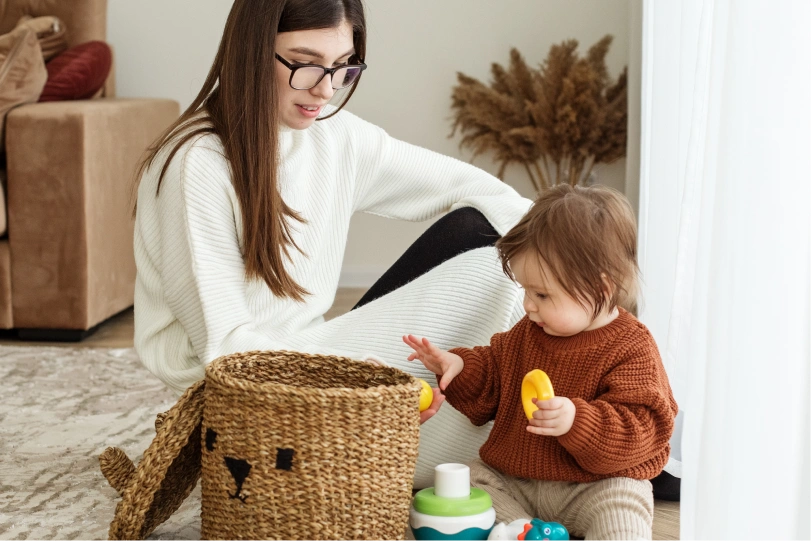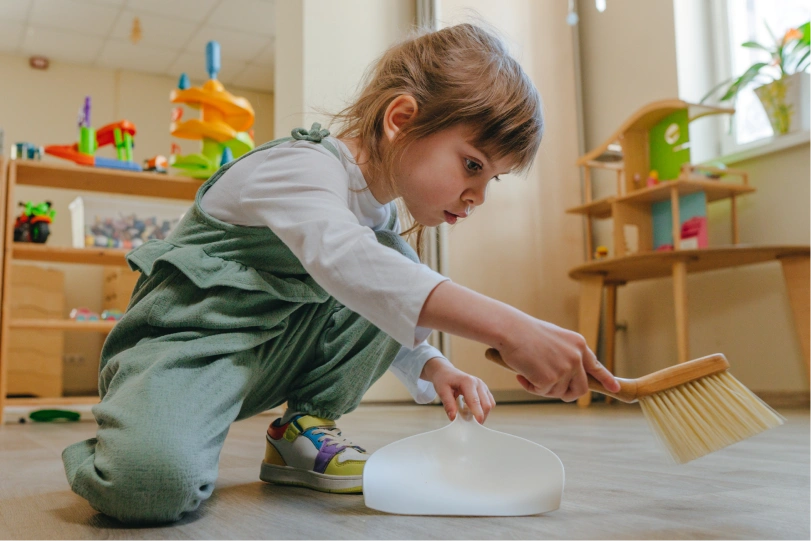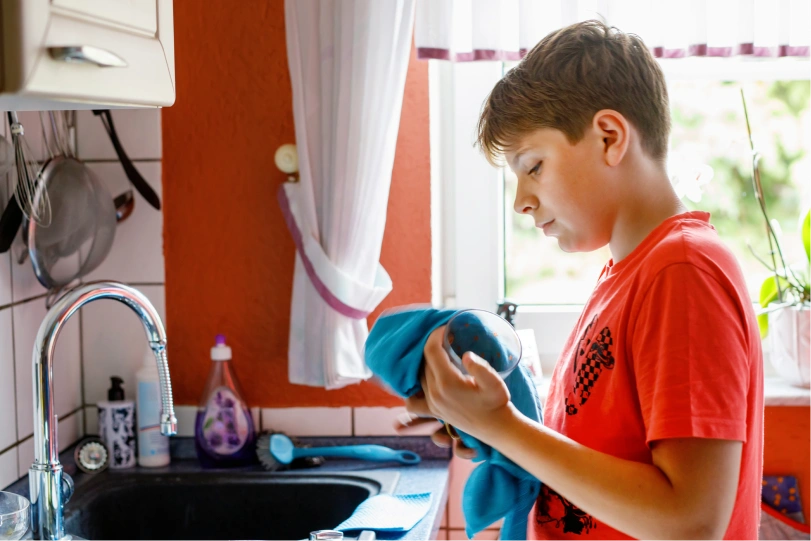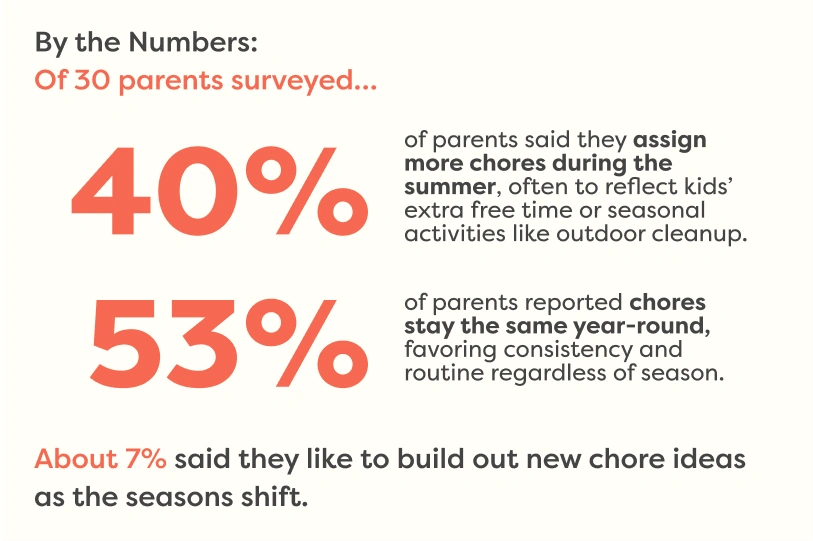Chores for Kids by Age

Why Chores Are Important for Kids (Even Toddlers)
Ever feel like you're the only one doing all the things? Yep, us too. Introducing chores isn’t about turning your kid into a cleaning machine. It’s about small wins, shared responsibility, and yes — finally having someone else take the dog out.
Starting chores young (even as early as 2 or 3) helps kids build confidence, life skills, and a sense of contribution. Plus, research shows chores support executive function, motor skills, and emotional intelligence. (Tepper et al., 2022)
"Chores can help kids feel like valued members of the household, giving them a sense of purpose and contribution that supports emotional development.
— Emily Oster, Founder of ParentData
This guide is grounded in advice from the Skylight Parent Panel — a community of real parents across the country who shared what’s actually worked in their homes. From toddler messes to teen resistance, their confessions, routines, and wins helped shape this age-by-age breakdown.
What’s the Best Age to Start Kids on Chores?
There’s no magic number, but earlier often means easier. Kids as young as 2 or 3 can begin helping if it feels like a game or a "special job."
“My kid started helping around the house around age three or four. Their first responsibilities were simple things like putting away toys, handing me items while I cooked, and helping wipe small spills.” - Dad of 1
“[My child] started chores around 3. First responsibilities were putting toys away and helping carry laundry to the basket.” - Mom of 3
“My kids started helping when they were around 6 years old. They were responsible for cleaning up the messes they made.” - Mom of 7
How to Introduce Chores
Whether you’re starting with a toddler or giving your teen the trash duties, the key to success is visibility and consistency.
"Regularly completing age-appropriate tasks builds responsibility and independence—taking out the trash at 8 isn’t the same as doing your own laundry at 14, but both matter.
— Emily Oster
That’s where the Skylight Calendar can help.
Skylight Calendar is a touchscreen family calendar that helps make routines clear and shared. With just a few taps, you can set up recurring reminders, assign tasks to different kids, and give everyone a better sense of what’s expected.
Here’s how parents use Skylight Calendar to manage chores:
-
Assign recurring chores to each child using color-coded profiles
-
Add emoji-based reminders for non-readers (like 🧹 for sweeping or 🐶 for feeding the dog
-
Create custom sections so chores don’t get lost in the mix with birthdays and soccer games
-
Give kids a go-to place to check what’s theirs to do (and get that little dopamine hit when it’s done)
When kids can see what’s expected of them — and when — they’re far more likely to follow through (with fewer reminders).
And sometimes, it’s not just about what we ask kids to do — it’s how we ask them. The language we use can completely change their willingness to help.
“My daughter is allergic to the words “clean” and “chores”. Re-wording tasks has been helpful. If only we knew two years ago!” - Mom of 2
Appropriate Chores by Age: A Full List
Chores for Kids Aged 2–3: Toddlers Who Love to Imitate
Toddlers want in on everything — folding laundry, feeding the dog, wiping the counter (with a sock). Toddler chores aren’t about results. They’re about letting your tiny sidekick feel like they’re helping, even if it takes twice as long and ends in a second spill.
Introducing simple chores for toddlers builds confidence, motor skills, and a sweet sense of “I did it!” It’s less about getting things done and more about participation and skill-building.
Try:
-
Picking up toys
-
Wiping up spills
-
Using a small dustpan
-
Helping water plants with a squirt bottle
-
Neatly arrange toys
"Even with the youngest kids there is an opportunity to use chores to build this independence — setting the utensils on the table at 3 or setting the table all together at 9 all builds towards raising adults."
— Emily Oster
Skylight tip: Let toddlers choose a chore emoji each week to give them a feeling of ownership.
“My 3-year-old waters the pumpkin seeds daily and helps bring the laundry to the laundry room. I also ask her and my one year old to help reset the playroom every week.” - Mom of 2
Chores for Kids Aged 4–5: Helpers in Training
They’re eager, somewhat chaotic, and ready for some independence. This age is peak “I can do it myself” energy — which is exactly why it’s the perfect time to introduce consistent routines. Will they fold towels into triangles and water the couch by mistake? Yes. But they’ll be proud of it.
Chores for preschoolers aren’t about efficiency. They’re about helping kids feel capable, confident, and like they’ve got a real role to play in the family. (Just be ready with backup — and a towel.)
Try:
-
Making the bed (even if it’s lumpy)
-
Watering plants
-
Matching socks or grouping clothes by color
-
Helping feed pets
-
Loading or unloading dishwasher safely
Skylight tip: Use a weekly “special jobs” routine. Create a custom category and let kids check off tasks.
“My four—almost five—year-old loves picking up. I have him clean up the toy room often and toss things into the bins. He also enjoys collecting sticks in the backyard and putting them in a trash bag.” - Mom of 2
Chores for Kids Aged 6–8: Starting to Take Initiative
At this stage, kids are hitting their stride. They’re reading instructions, making real decisions, and starting to take pride in doing things by themselves. They may still need reminders, but they love being trusted with grown-up tasks — and celebrated for it.
The key? Keep expectations clear, give them real ownership, and use tools like Skylight Calendar to help them track what’s theirs to do. Add their name, an emoji or two, and let the satisfaction of checking it off do the rest.
Try:
-
Packing lunch (with a little guidance)
-
Emptying the dishwasher or drying dishes
-
Folding laundry (start with towels)
-
Sweeping or vacuuming small spaces
-
Helping feed pets (and remembering when it’s their turn)
“My son is really into organizing so unloading the dishwasher has been a great fit. He likes putting things in the right spots and feels proud when everything looks neat. He also doesn’t mind vacuuming since it feels kind of like a machine game to him.” - Dad of 2
Related Reading: Benefits and Tips for Creating a Daily Schedule for Kids
Chores for Kids Aged 9–12: Capable, With a Side of Resistance
Kids in this age range are juggling more — schoolwork, activities, opinions — and they’re more aware of how the household runs. They may grumble, but they’re also proud to be seen as capable. This is a great age to level up their responsibilities and loop them into routines that actually matter to the family.
Use Skylight Calendar to give them more control: let them manage their own tasks, track who’s on dishwasher duty, or take turns scheduling who walks the dog. When the system is fair and visible, there’s less room for arguments — and more follow-through.
Try:
-
Cleaning their room (and maybe even organizing it)
-
Taking out the trash or recycling
-
Managing their own school lunch, water bottle, and activity bag
-
Vacuuming or sweeping common areas
-
Watering plants or weeding the garden
-
Folding laundry and putting it away
“Our 10-year-old vacuums the whole house twice a week. It started with just his room, but he actually liked it—so now it’s kind of his thing.” — Dad of 2
Chores for Teens: The Household MVPs
They’ve got busy schedules, big opinions, and a talent for not hearing you until the third time you say something. But teens are ready for real responsibilities — especially if they get a little control and don’t feel like they’re being micromanaged. They might roll their eyes, but they’ll still get it done (eventually).
Try:
-
Doing their own laundry
-
Cleaning shared spaces
-
Managing chore schedules with siblings
-
Grocery list planning or simple cooking
-
Managing their own calendar or adding events to the family calendar
“My 13-year-old actually loves prep cooking. Chopping veggies, getting ingredients ready—that kind of thing. I just stay out of the way.” — Dad of 4
Summer Chore Ideas for Kids: Age-Appropriate Tasks for the Break
Summer is the good stuff. Bare feet. Late bedtimes. Sticky fingers from one too many popsicles. It’s also a time when routines go out the window — which is part of the magic, and part of the mess.
That’s where a few simple summer chores for kids can help. They add just enough structure to keep things running smoothly (and your counters clear), without taking away from the fun. Think: light routines, visible expectations, and moments that build independence.
Here are some easy, age-appropriate chore ideas to weave into your family’s summer flow:
Outdoor Helpers
-
(Ages 3–5): Water flowers, plants, or small garden beds
-
(Ages 6–8): Sweep the porch or patio
-
(Ages 6–12): Check the mail or bring in packages
-
(Ages 8–12): Hose down bikes, scooters, or summer gear
Meal Prep Sidekicks
-
(Ages 6–10): Unpack farmers market bags or wash produce
-
(Ages 4–8): Refill water bottles for the day
-
(Ages 5–10): Set up or clear the table for outdoor meals
-
(Ages 8–12): Make a snack tray to share with siblings or friends
Cleanup Crew
-
(Ages 5–7): Wipe down popsicle-sticky chairs or outdoor tables
-
(Ages 6–9): Gather pool towels
-
(Ages 6–10): Sort and fold swimsuits or summer clothes
-
(Ages 9–12): Help pack the beach or park bag for the next day
Event Planners (in training)
-
(Ages 8–12): Add upcoming summer outings to the Skylight Calendar
-
(Ages 8–12): Prep their own camp or activity bags the night before
-
(Ages 10–14): Help choose one dinner each week and add ingredients to the grocery list
Skylight tip: Use custom categories like “Summer Jobs,” “Outside Tasks,” or “Adventure Prep” to group chores. Then let kids claim their own to-dos each week — it feels more like a mission, less like a demand.
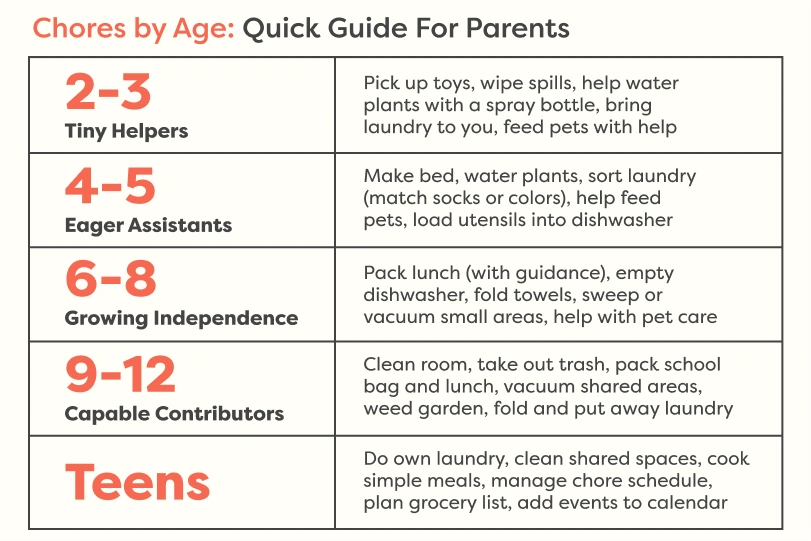
Need help assigning chores? Try using the Skylight Calendar to set visual reminders that work for the whole family.
How to Get Kids to Do Chores
Chores won’t be the highlight of the day — but they don’t have to be a battle, either. With a little structure, clear expectations, and tools that make routines easier to see (and stick to), chores can become a natural part of the day — like snack time, or arguing over whose turn it is to pick the show.
Here’s what’s actually worked for parents surveyed by Skylight:
“We give them money in a ‘bank’ that they can use when we go places, or to buy extra snacks and treats from the pantry during the week beyond the normal allotment. Almost like a convenience store at home.” - Dad of 2
“We do a weekly countdown of helping out around the house. This mainly means collecting the dogs' empty food dishes, cleaning the playroom, bringing laundry out, and taking toys back to their respective rooms. After they do four weeks worth we treat them to ice cream. It is something they really look forward to and allows us to teach responsibility while also keeping family time as a positive incentive.” - Mom of 2
“One thing that really works for us is using a simple checklist with pictures for my little one, so they know exactly what to do and can feel proud checking things off. We also make chores part of our daily routine, like tidying up right before dinner, which keeps it consistent without feeling like a big hassle.” - Dad of 1
Pro tip: Let your kids choose their own task from a short list — autonomy turns resistance into buy-in.
FAQ: Age-Appropriate Chores for Kids
What are good chores for a 5-year-old?
Age-appropriate chores for 5-year-olds include watering plants, setting the table, and cleaning up toys.
When should kids start doing chores?
Kids as young as 2 or 3 can start simple chores like wiping spills or putting toys away. Start small and make it fun!
How do I make a chore chart that works?
Keep it simple, visual, and consistent. Start with 1–2 tasks, and use tools like the Skylight Calendar to help build routines.
Special thanks to…
-
Emily Oster, CEO of ParentData, mom of two, best-selling author, PhD graduate in economics from Harvard, and professor of economics at Brown University.
-
The Skylight Parent Panel, our community of parents sharing what’s worked for them — real routines, honest moments, and tips from everyday life

